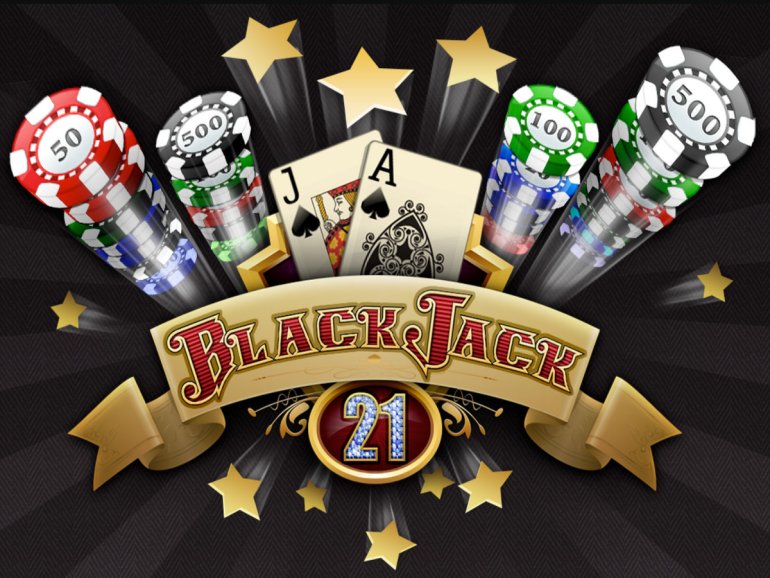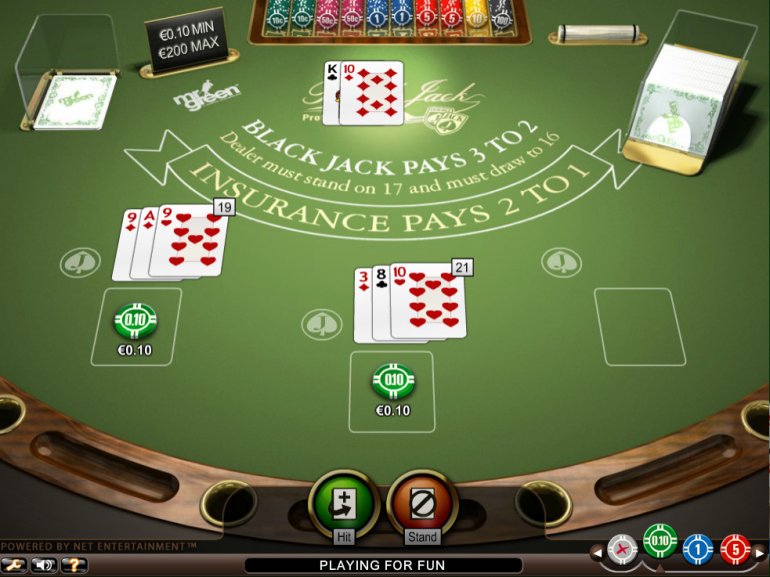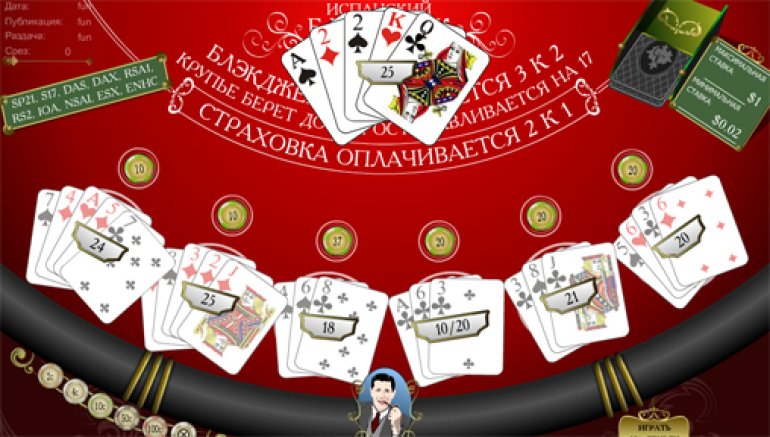
Blackjack Description
The game is played at the blackjack table with standard 52-card decks without jokers. Their number can range from one to eight.
- If one deck is used, the croupier deals the cards and shuffles them after each hand.
- If several decks are used, they are placed in a particular device called a shoe.
The shoe is located on the left of the dealer. The discard tray is located on the right side. Sometimes a shuffle machine plays the role of a shoe, shuffling cards automatically.
The aim is to score twenty-one points, or the score that is at most close to this amount without exceeding it.
If a player scores more than twenty-one points, he immediately loses. In other cases, the rank of his cards is compared with the dealer's cards, and the winner is determined.
A ten-value card and an ace that form a hand are called blackjack. It is the only hand in the game with a name, and it is superior to the rank of any other cards.
Card Values in BJ
Cards from deuces to tens are worth their numeral values. The values of jacks, queens, and kings are ten points. An ace is worth either one or eleven points. This choice is made in favor of the player.
For example, if the hand is composed of an ace and a six, the player has five or fifteen points. If he draws a six, the player gets twenty-one points.
At some casinos, the turn automatically moves to the next hand. At other casinos, it is announced that he has either eleven or twenty-one, so the player chooses whether to draw another card or not.
However, if the player draws a seven, it will be considered that he has twelve points instead of twenty-two.
Players and Bets in BJ
The number of players is limited by the number of boxes (betting sectors). Their traditional number is seven. Yet, this does not mean that players can make combined bets on one box. It is important to note that their amount can not exceed the maximum limits allowed for a given table.
It is prohibited to play on one box at many casinos, so the player has to make at least two bets. The maximum number of bets per player is established by each casino.
Blackjack Gameplay
The dealer thoroughly shuffles all the decks, separating the part of cards (from the fifth one to the third one) with a special plastic card and putting them all in a shoe. During the gameplay, he takes cards from it one by one and gives them to the players and himself.
Discarded cards are placed in a special discard tray and are present there until the plastic card leaves the shoe. The hand in which it happens is announced as the final one. After it, all the cards are reshuffled.
Having prepared the cards for the game, the dealer offers players to wager. Then he stops accepting bets and starts dealing cards.
In the basic American version of the game, the croupier deals two cards to all players and himself. He reveals one of his cards.
There is also a version of the rules according to which the croupier deals himself with only one card, and the others are deals after all players receive their cards.

If blackjack is formed on any box, the dealer's face-up card eliminates the possibility of the same combination in his hand (i.e., this card value varies between two or nine points). He immediately pays for blackjack and puts cards in the discard tray.
- If the dealer's upcard is an ace or a ten-value card, blackjack is not paid till the showdown.
- If the dealer's upcard is an ace, he offers the player who has blackjack the so-called even money, according to the rules of some casinos. This means that he will pay 1:1 for blackjack and discard cards.
Players evaluate the rank of their hands and decide whether to hit or stand, taking into account the rank of the upcard. Any number of cards can be drawn, provided that the score does not exceed twenty-one.
The cards are strictly drawn by the game participants strictly one by one. The first is located to the left of the dealer. As soon as the decisions concerning all boxes are made, the dealer faces up his second card. If necessary, the croupier hits and compares the resulting hands. The dealer only hits in situations provided by the rules. The croupier has to hit on a 16 or less and stand on a 17 or more.
The player cannot touch his cards. All operations with them are carried out by the croupier.
Winning hands are paid 1:1. Blackjack is paid 3:2 (blackjack made up of cards of the same suit is paid 2:1 at some casinos.)
Additional Blackjack Rules
Here are some more rules.
- Split - If the player has a pair (or even cards of the same value, i.e., a queen and a king, at some casinos), he can split them into two hands by making another bet of the same size. After that, the player can hit again. If a card of the same value is added to the hand, it can be split again. The number of available splits on one box varies, but it usually does not exceed three. If the user splits aces, only one card is usually dealt. Then the game moves to the next box. If an ace is dealt once again, the user can do a split. An ace and any ten-value card formed as a result of the split are not considered to be blackjack and are treated as twenty-one points (this means that this hand loses if the dealer has blackjack.)
- Double - Having received the first two cards, the player may make a double. To do this, he should double his initial bet. After that, one card is dealt on this box, and the croupier proceeds to the next player and reveals his cards.
- Triple - is a rule that is valid not at all casinos. It allows players to make another bet equal to the initial bet after the double and receive an additional card.
- Surrender - Having received the first two cards, the player may refuse to play and return half the bet. It should be noted that this rule is not valid at nearly all casinos if the dealer has a face-up ace. Moreover, it is often canceled if the dealer has a ten-value card.
- Insurance - If the dealer has a face-up ace, he offers the players to take insurance against blackjack. The size of insurance is equal to half the initial bet. It is paid 2:1 if the dealer will have blackjack.
In some variants of the game, there are unique rules, such as the Charlie rule.
Versions of Blackjack
There are several variations of classic blackjack. The main difference is the number of cards dealt by the croupier to himself at the beginning of the round. Besides, there are versions of rules where the croupier deals two cards. Most casinos reserve the right to adjust to such rules as surrender, double, split, payouts for blackjack, and others.

Sometimes there are bonus rules that include high additional payouts for three sevens on one hand. Some unprofitable rules can be offered; for example, the highest number of cards per hand can be limited.
Read more about this in the article Unusual Rules in Blackjack.
Read about the house edge and probability of various situations in blackjack in the article Odds in Blackjack.
Where to Play Blackjack in New Zealand
We recommend that you evaluate your knowledge of the basics of blackjack at 888 Casino, Tropez Casino, and SpinPalace right now.
If you want to train to play BJ for free, go to the Games section of Casinoz and read the reviews. In the articles, there are free BJ demos.

























